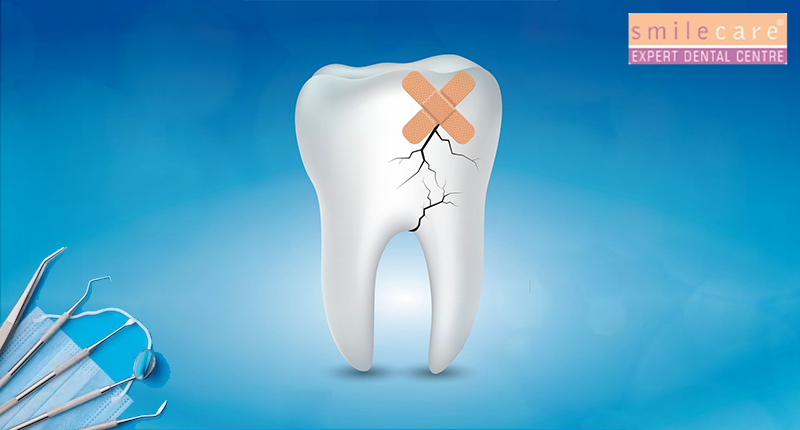Be it the enamel or the crown; there can be a crack on any of your teeth. A fractured tooth can be a result of chewing hard foods, grinding of teeth at night, or occurring naturally as you age. It’s a natural condition, yet the leading cause of tooth loss across the world.
If you’ve a cracked tooth, you might experience a variety of symptoms. Be it erratic pain while chewing foods or sudden twitching when feeling extremely cold, pain may come and go. At times, it is difficult for the dentist to find the tooth causing such discomfort. It’s best to visit an endodontist if you experience any symptoms of a cracked tooth.
Causes of a Cracked Tooth
A fractured tooth is a common dental problem that ranges from a small crack to a severe fracture that extends deep into the tooth. A fractured tooth is often painful and may require proper dental attention.
A tooth fractures due to many reasons. Some of the following reasons are:
- Pressure from teeth-grinding
- Large fillings often weaken the integrity of the tooth
- Chewing or biting hard food items such as hard candies, walnuts, ice, etc.
- Accidents or blows to the mouth while fist fighting, falling on the ground, etc.
- Sudden change in temperature in the mouth. For instance, eating scorching food items and suddenly drinking cold water.
- Age. A fractured tooth naturally occurs at the age of 50 and above.
Infected Cracked Tooth Symptoms
A fractured tooth’s symptoms vary depending on the crack’s severity and position. Following are some common infected cracked tooth symptoms:
- Pain when chewing: You may experience sharp or intermittent pain when biting down or chewing, especially when releasing the bite.
- Sensitivity to hot and cold: You might notice heightened sensitivity to temperature changes, particularly with hot or cold foods and beverages.
- Pain when releasing biting pressure: Releasing the pressure on the cracked tooth can cause pain.
- Swollen gums: In some cases, the gum tissue around the cracked tooth may become swollen or painful.
- Visible crack: If the crack is large or extends to the surface of the tooth, it may be visible to the naked eye.
- Tongue or cheek irritation: A sharp edge or irregular surface on the cracked tooth can irritate the tongue or cheek.
Treatment For A Cracked Tooth
There are many factors a dentist considers when treating a cracked tooth. Some include the size of the crack, its location, and your symptoms. Accordingly, your dentist or endodontist may suggest you with one of the following procedures:
- Bonding
Under this procedure, the dentist will use a plastic resin to fill the crack. It helps to restore its look and functioning. Usually, a dentist uses dental bonding materials to repair and seal the crack.
- Dental Veneers
The Dental Veneer procedure is suitable for more extensive damage or cosmetic improvement. It involves bonding the front of the tooth with thin porcelain shells. It’s a little more expensive than dental bonding but provides a natural appearance and long-lasting results.
- Dental Crown
This procedure is used for severely cracked or broken teeth, mainly caused by major accidents. The dentist will cap the damaged area, covering the entire teeth to restore its strength and appearance. Furthermore, it offers protection against further damage.
- Root Canal Therapy
Root Canal Therapy is used in extreme cases when a fracture reaches the pulp. This process involves removing infection or damaged tissues. Onwards, the dentist will cleanse the root canal and seal it. It preserves the fractured tooth while eliminating pain.
Complications of a Cracked Tooth
Bacteria infection spreading to the bones and gums is the biggest complication of a cracked tooth. Following are some symptoms of a dental infection:
- Fever
- Pain while chewing foods
- Sensitivity to heat and cold
- Bad breath
- Tender glands in the neck region
Most dentists try to drain pus from the infected region and then prescribe an antibiotic to kill the bacteria.
To Conclude:
Many individuals commonly experience a cracked tooth. From root canals to dental bonding, various procedures are available to save the tooth and bring your smile back.
Although a cracked tooth can be repaired, it cannot be totally healed. However, prompt treatment with the proper consultation offers the best chances of saving your tooth while preventing infections and further damage. The key is to consult with a dentist who specializes in assessing the severity of the fracture and recommend the best suitable treatment option that fits your fractured tooth.
For more information regarding Fractured Tooth treatment, connect with us today. We will be happy to assist you.Keep Smiling!
FAQ
1. What causes a cracked tooth?
A cracked tooth can result from various factors, including biting on hard objects, teeth grinding, dental trauma, or natural wear and tear.
2. What are the common symptoms of a cracked tooth?
Common symptoms include sharp pain when biting or chewing, sensitivity to hot or cold temperatures, intermittent discomfort, and potential swelling or gum tenderness.
3. How is a cracked tooth diagnosed?
Diagnosis typically involves a dental exam, X-rays, and sometimes the use of special dental instruments to identify the location and extent of the crack.
4. Can a cracked tooth heal on its own?
No, a cracked tooth won’t heal on its own. It requires dental treatment to prevent further damage and relieve symptoms.
5. Is it important to seek treatment for a cracked tooth?
Yes, it’s crucial to seek treatment promptly. Ignoring a cracked tooth can lead to more severe damage, infection, and increased pain.

